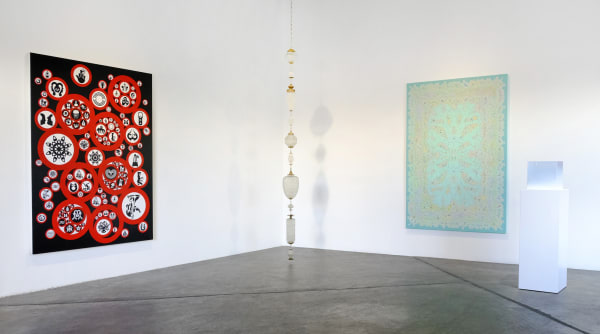Mel Bochner
Mel Bochner (b. 1940) is recognized as one of the leading figures in the development of Conceptual art in New York in the 1960s and 1970s. Emerging at a time when painting was increasingly discussed as outmoded, Bochner became part of a new generation of artists which also included Eva Hesse, Donald Judd, and Robert Smithson - artists who, like Bochner, were looking at ways of breaking with Abstract Expressionism and traditional compositional devices. His pioneering introduction of the use of language in the visual, led Harvard University art historian Benjamin Buchloh to describe his 1966 Working Drawings as ‘probably the first truly conceptual exhibition.'
Mel Bochner came of age during the second half of the 1960s, a moment of radical change both in society at large as well as in art. While painting slowly lost its preeminent position in modern art, language moved from talking about art to becoming part of art itself. Bochner has consistently probed the conventions of both painting and of language, the way we construct and understand them, and the way they relate to one another to make us more attentive to the unspoken codes that underpin our engagement with the world.
-

Mel Bochner
Money, 2006 May 27 - Jun 14, 2025 7722 GirardQuint Gallery is pleased to present Money , a 2006 painting by Mel Bochner (1940–2025), on view at 7722 Girard Avenue. Often associated with the Conceptual Art movement, Bochner’s early...Read more -

Quint Popup in Los Angeles
Feb 7 - 19, 2023This month, Quint Gallery is heading to Los Angeles. From February 7-19, we're popping up at the Bergamot Station Arts Center in Santa Monica, exhibiting a selection of paintings, drawings,...Read more -

WORKS ON PAPER II | Group Exhibition
Quint Contemporary Art: 7547 Girard Avenue Aug 3 - Sep 7, 2013Quint Contemporary Art (QCA) is pleased to present ROY MCMAKIN: Some Drawings and a Table , a solo exhibition by Roy McMakin and WORKS ON PAPER II: Work by Peter...Read more -

Troublesome | Group Exhibition
Quint Contemporary Art: 7547 Girard Avenue Jan 12 - Feb 23, 2013QCA is excited to present TROUBLESOME, a group exhibition of paintings, sculpture and photographs by Robert Barry, Mel Bochner, Matthew Brandt, Johnannes Girardoni, Thomas Glassford, Katrin Korfmann, Joao Lauro, Lee...Read more -

Mel Bochner | words...
Quint Contemporary Art: 7547 Girard Avenue Mar 3 - Apr 14, 2012“It is the opacity of our language and the way in which it predetermines our sight that intrigues me.” – Mel Bochner Quint Contemporary Art (QCA) is very pleased to...Read more -

Double Up Double Up | Group Exhibition
Quint Contemporary Art: 7739 Drury Lane Jun 11 - Jul 3, 2010Quint Contemporary Art is pleased to announce the opening of Double Up Double Up , which opens on Friday, June 11 and runs thru July 3, 2010. We are excited...Read more -

Mel Bochner | Drawing From Four Decades
Jan 5 - Feb 10, 2007Quint Contemporary Art is pleased to present an exhibition of recent paintings by Mel Bochner. The show will run from January 5th to February 10th, 2007 with a reception on...Read more










